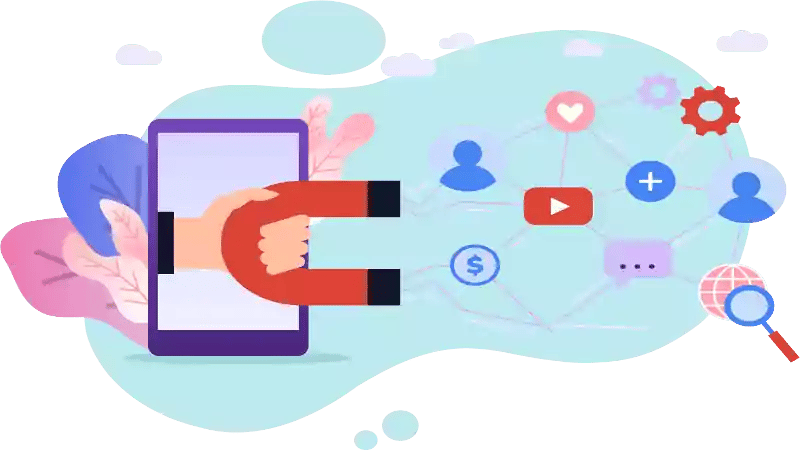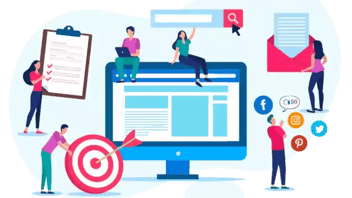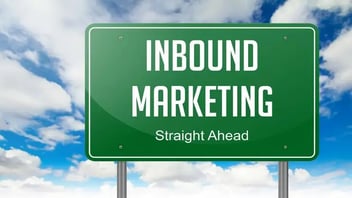Attract, Engage, and Delight: The Inbound Methodology
In today's competitive digital marketing, businesses constantly seek new and effective strategies to connect with their target audience. The inbound methodology, a customer-centric marketing approach, has emerged as a powerful tool for attracting, engaging, and delighting customers and fostering business growth.
The Inbound Marketing Methodology
Inbound marketing is a transformative and customer-centric approach in three stages, with inbound marketers prioritizing attracting, engaging, and delighting audiences to build lasting relationships. Unlike traditional outbound marketing methods that interrupt and push messages onto potential customers, when implementing an inbound marketing effort, we seek to naturally attract individuals toward a brand by providing valuable content and personalized experiences and naturally converting visitors into leads.
Key Characteristics of Inbound Marketing:
-
Customer-centric approach
-
-
Prioritizes understanding and addressing the needs of the target audience.
-
Focuses on creating meaningful interactions that resonate with the individual buyer persona.
-
-
Permission-based communication
-
-
Seeks permission to engage with the audience rather than imposing messages.
-
Empowers individuals to opt in to receiving information and high-quality content.
-
-
Value-driven content creation
-
-
Emphasizes the creation of valuable, relevant, and educational content.
-
Aims to address customer pain points and provide solutions to their challenges.
-
-
Multi-channel engagement
-
-
Utilizes various online channels, including social media, blogs, and email.
-
Adapts strategies based on where the target audience is most active.
-
-
Building trust and credibility
-
Establishes trust by consistently delivering valuable and authentic content.
-
Positions the brand as a reliable source of information within its industry.
An inbound marketing strategy diverges from traditional outbound strategies, which rely on interruptive advertising and mass communication. Instead, it recognizes that today's consumers are more empowered, seeking information on their terms. Inbound aligns marketing efforts with the decisions of modern buyers, emphasizing the importance of providing value before expecting anything in return.
The inbound methodology comprises three pivotal stages: Attract, Engage, and Delight. This methodology aims to guide individuals through the customer journey, from awareness to consideration and decision. This strategy enables brands to acquire customers and build long-term, meaningful relationships.
As we delve into the inbound methodology, the subsequent sections will unveil the intricacies of each stage, providing actionable insights to empower brands in transforming their marketing strategies.
Improve Your Marketing Skills with HubSpot Academy
Attract: Drawing Potential Customers
The first step in using the Inbound marketing methodology is the "Attract" stage, a strategic process to draw potential customers to your digital doorstep. It's about creating content marketing with a magnetic pull through valuable, relevant, and tailored content. In an era of rampant information overload, capturing attention requires finesse.
Creating helpful content isn't merely about producing generic information. It's about crafting content that attracts exemplary visitors, resonates with your target audience, addresses their pain points and questions, and provides actionable solutions.
This involves a comprehensive understanding of your buyer personas – who they are, their challenges, and what solutions they seek. Marketing materials should provide audio, visual, or written content to help address key questions during the initial stage of the buyer's journey.
Diversification is critical when it comes to content creation. A successful attract strategy involves deploying various content formats such as blog posts, infographics, and videos. Each format serves a unique purpose, catering to diverse preferences and consumption habits. Blog posts establish your brand's authority, infographics simplify complex information, and videos engage audiences visually.
Increasing website traffic is the pivotal goal of a marketer in the Attract stage, and this is where Search Engine Optimization plays a crucial role. Conducting thorough keyword research ensures that your content aligns with what your audience is actively searching for. By optimizing meta tags, including compelling headlines and engaging meta descriptions, you not only improve your search engine visibility but also entice users to click through, increasing the organic traffic to your website.
SEO leads have a 14.6% close rate (HubSpot), compared to 3.1% for paid leads.
Attract Stage - Best Practices:
-
Create relevant content
-
-
Understand your target audience's pain points, questions, and challenges
-
Craft content that provides actionable solutions and resonates emotionally
-
Regularly update content to stay relevant and address emerging trends
-
-
Diversification in content creation
-
-
Utilize various formats such as blog posts, infographics, and videos
-
Tailor content to suit different audiences and preferences
-
Experiment with varying types of content to gauge audience engagement
-
-
Increase website traffic
-
Conduct thorough keyword research to identify relevant search terms
-
Optimize meta tags, including compelling headlines and meta descriptions
-
Regularly audit and update content to align with changing SEO trends
In essence, the attract stage sets the foundation for a successful inbound strategy. It's about more than just visibility; it's about strategically positioning your brand in a way that resonates with your audience, drawing them in with content that speaks directly to their needs and desires.
Engage: Building Relationships with Leads
Having successfully drawn potential customers into your brand's orbit, the second stage of the inbound marketing approach, "Engage," becomes the focal point.
In the Engage stage,
-
It's not about acquiring leads or converting anonymous visitors into known contacts by fooling them into providing their contact information on a clickbait landing page without offering something in return;
-
It is about fostering meaningful relationships through personalized and targeted interactions that resonate with the individuality of each prospect.
-
It is designed to motivate the qualified buyer to transition from initial awareness of your company's presence to actively considering your product or service. It is about the transition from anonymous data points in Google Analytics to becoming marketing-qualified leads.
Personalization is the cornerstone of effective engagement. In the world of digital communication, generic approaches fall short. Email marketing, when personalized, becomes a powerful tool for engagement. Tailoring your communication to customer behavior, preferences, and interactions creates a sense of individualized attention, thereby enhancing the overall customer experience.
74% of buyers say personalized content makes them more likely to convert.
80% of marketers say that personalized email marketing increases open rates.
Social media marketing is another avenue for meaningful interactions. Beyond being platforms for broadcasting, social media channels are spaces for genuine conversations. Actively responding to comments and direct messages and engaging in relevant discussions humanizes your brand and deepens your connection with your audience.
Engage Stage - Best Practices:
-
Personalize interactions
-
-
Segment your email lists based on demographics, behavior, and preferences
-
Tailor email content to each segment, providing relevant and personalized information
-
Use dynamic content to personalize messages based on user interactions
-
-
Social media engagement
-
-
Actively respond to comments, direct messages, and mentions
-
Participate in relevant conversations to showcase the human side of your brand
-
Schedule posts at optimal times based on your audience's online activity
-
-
Utilize marketing automation tools
-
Implement workflows that nurture leads through the sales funnel
-
Set up automated email campaigns for different stages of the customer journey
-
Use automation to track and analyze customer interactions for continuous improvement
Utilizing marketing automation tools is a strategic move to streamline engagement processes. Automation enables you to send timely and relevant messages to your audience, ensuring your brand remains top-of-mind throughout the customer journey. Implementing workflows that nurture leads based on their interactions and behavior is pivotal in guiding prospects seamlessly through the sales funnel.
Ultimately, the Engage stage is about transforming casual interest into a genuine connection. It's about acknowledging the uniqueness of each customer and tailoring your interactions to foster relationships beyond transactional exchanges.
Delight: Exceeding Expectations
As we enter the final stage of the Inbound Methodology, "Delight" takes center stage. The focus here is not merely on transactions but on delighting your customers and providing exceptional customer experiences that leave lasting impressions and transform satisfied customers into devoted brand advocates and promoters of your business.
Exceptional customer experiences are the bedrock of the delight stage. Beyond the point of sale, customers remember how they were treated. Customer support becomes a critical component, requiring prompt and helpful responses to inquiries and concerns. A seamless and user-friendly online experience enhances customer satisfaction, making it easy for them to navigate your platforms and find what they need.
Turning customers into promoters is the ultimate goal of the delight stage. Encouraging customer reviews and testimonials is a powerful strategy to showcase positive experiences. Positive fee dback not only serves as social proof for potential customers but also provides valuable insights for continuous improvement. Implementing loyalty programs further incentivizes repeat business, rewarding customers for their continued support and converting satisfied customers into proactive brand promoters.
67% of customers say that positive experiences with a brand make them more likely to recommend it to others.
Delight Stage - Best Practices:
-
Exceptional customer experiences
-
-
Prioritize prompt and helpful customer support across all channels
-
Optimize website navigation and design for a seamless user experience
-
Seek customer feedback and actively address concerns to improve customer service
-
-
Turning customers into prospects
-
Encourage and incentivize customer reviews and testimonials
-
Implement loyalty programs with exclusive offers and rewards
-
Showcase positive customer experiences through case studies and success stories
The delight stage is the culmination of the inbound methodology, where customers transition from being buyers to becoming brand advocates. It's about going the extra mile, exceeding expectations, and leaving an indelible mark that ensures your brand stays top-of-mind in the competitive landscape.
General Tips for Inbound
-
Consistent brand voice: Maintain a consistent tone and voice across all content and interactions to reinforce brand identity.
-
Analytics and iteration: Regularly analyze performance metrics and customer feedback to refine and iterate your inbound strategy.
-
Customer journey mapping: Understand and map the customer journey to identify touchpoints and optimize the inbound process.
-
Align sales and marketing: Foster collaboration between sales and marketing teams to ensure a seamless conversion of leads into customers. Inbound sales teams and processes seamlessly continue the buyer's inbound experience by connecting them with your products and services.
-
SEO optimization: Implement a robust SEO strategy to enhance online visibility. Conduct keyword research, optimize meta tags, and ensure the content aligns with the search intent to improve search engine rankings and attract organic traffic.
-
Provide personalized and timely insights: Create persona-relevant forms of content for every stage of the buyer's journey. Those who encounter your company want to know about the problems you solve before hearing about the discounts you have to offer.
-
Stay current with trends: Stay informed about industry trends, changes in search algorithms, and emerging technologies to adapt your strategy accordingly.
The Benefits of the Inbound Marketing Process
With its customer-centric approach and strategic stages of attracting, engaging, and delighting, the inbound methodology brings about transformative impacts that extend far beyond traditional marketing methods. This methodology, often characterized by its emphasis on creating value and fostering relationships, yields numerous benefits for businesses seeking to thrive in the digital age.
Customer-centric Focus
At the core of the inbound methodology is a profound shift towards understanding and addressing the needs of the customer. By placing the customer at the center of marketing strategies, businesses move away from intrusive, one-size-fits-all approaches to personalized and relevant interactions. This customer-centric focus is essential for building trust and fostering long-term relationships.
Lead Quality Improvement
One of the standout benefits of the inbound methodology is its ability to attract high-quality leads. By creating valuable content that aligns with the interests and pain points of their target audience, businesses naturally attract individuals who are actively seeking solutions. The subsequent engagement stage refines these leads through personalized interactions, resulting in a more qualified and engaged audience.
Enhanced Brand Authority and Visibility
The inbound methodology significantly elevates a brand's authority within its industry. Through the creation and dissemination of valuable content, businesses position themselves as thought leaders and experts in their field. This not only attracts more potential customers but also strengthens the brand's overall credibility. Additionally, optimizing content for search engines enhances online visibility, ensuring the brand is easily discoverable.
Cost-effective and Sustainable Growth
In contrast to traditional outbound marketing, which often involves substantial upfront costs, inbound marketing is a cost-effective and sustainable approach. Creating valuable content acts as a long-term asset, continuously attracting and engaging audiences over time. As content retains its relevance, the cost per lead decreases, making inbound marketing an economically efficient strategy for sustained growth.
Improved Customer Retention and Advocacy
The delight stage of the inbound methodology is designed to provide exceptional customer experiences. By consistently exceeding customer expectations, businesses not only retain customers but also turn them into advocates. Satisfied customers are more likely to share their positive experiences, contributing to organic word-of-mouth marketing and brand advocacy.
Adaptability and Measurable Success
The inbound methodology's adaptability is a crucial advantage in the ever-evolving digital landscape. Businesses can continuously refine their strategies based on real-time data and analytics, ensuring that marketing efforts remain relevant and practical. The methodology's measurable nature enables the tracking of key performance indicators, allowing for data-driven decision-making and continuous improvement.
Unlock Growth with the Inbound Methodology
The inbound methodology is more than a marketing strategy; it's a holistic approach that reshapes how businesses connect, engage, and thrive in the digital landscape. Its impacts and benefits, from fostering authentic connections to attracting high-quality leads and enhancing brand authority, underscore its transformative power. By prioritizing customer needs and creating meaningful interactions, businesses can navigate the complexities of the modern market with resilience and agility.
Are you looking for a boost to kick off the inbound methodology in your business? From crafting compelling content to optimizing SEO strategies and fostering customer relationships, Aspiration Marketing team members can provide the expertise and support needed to implement and excel in inbound and drive growth.
This content is also available in:
- German: Anziehen, engagieren und begeistern: Die Inbound-Methodik
- Spanish: Atraer, Convertir, y Deleitar: La Metodología Inbound
- French: Attirer, Engager, et Enchanter: La Méthodologie Inbound
- Italian: Attirare, coinvolgere e deliziare: La metodologia inbound
- Chinese: 吸引、互动、愉悦:入站营销方法









Leave a Comment